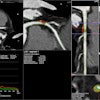Dear Advanced Visualization Insider,
The surging popularity of medical 3D printing belies the reality that it's still a relatively new field, mostly lacking formal guidelines and practiced by a small number of early adopters. The process of 3D printing is still extremely complex, with myriad ways for things to go badly. How can radiologists consistently produce high-quality models? With quality control, of course.
A recent presentation at the RSNA 2016 meeting discussed how a quality control program for 3D models can help ensure that the final product matches patient anatomy. Covering everything from high-quality image acquisition to segmentation of the image data, our Insider Exclusive shows how experts at the University of Pittsburgh do it.
In cardiac imaging, fractional flow reserve CT (FFR-CT) is increasingly touted as a good solution for determining the hemodynamic significance of coronary artery lesions -- and so it is. But as valuable as a negative finding on coronary CT angiography can be for predicting event-free survival, when an intermediate coronary lesion is present, CT can't determine whether or not it is limiting blood flow to the heart. FFR-CT can, but could a new technique based on machine learning do the same job as well or even better? Researchers from Europe and the U.S. tested a machine learning algorithm and found some intriguing results.
Also from RSNA 2016 in Chicago, investigators from the U.S. National Institutes of Health (NIH) took on the task of separating lymph nodes from surrounding anatomy that looks very similar on CT. They applied neural networks and structured optimization methods to create an automated segmentation scheme that appears to work. Learn how that helps clinicians and read the rest of the story by clicking here.
Deep learning techniques can teach new tricks to modalities as old as chest radiography to create a more comprehensive and "human-like" diagnosis, according to another study from the NIH. The investigators trained a deep learning framework on a database of chest x-rays and report summaries that had been annotated using standardized terms, offering a promising first step toward automated assessment of medical images.
In 3D printing, researchers from Boston weren't satisfied with the vague descriptions of utility provided by the end users of complex 3D models. Specifically, how are they useful for preparing a patient for surgery, or for improving understanding of a tumor? The team's systematic assessment of the benefits of 3D-printed models of lung cancer patients revealed information about what the models are good for and when they should be used. Click here to learn more.
Finally, advanced visualization techniques are helping scientists improve their understanding of bird beaks, in addition to providing state-of-the-art images of the fetus that offer a new level of realism.
For more important news about advanced visualization in radiology, computer-aided detection, 3D printing, and more, be sure to scroll through the links below -- all here in your Advanced Visualization Community.



















